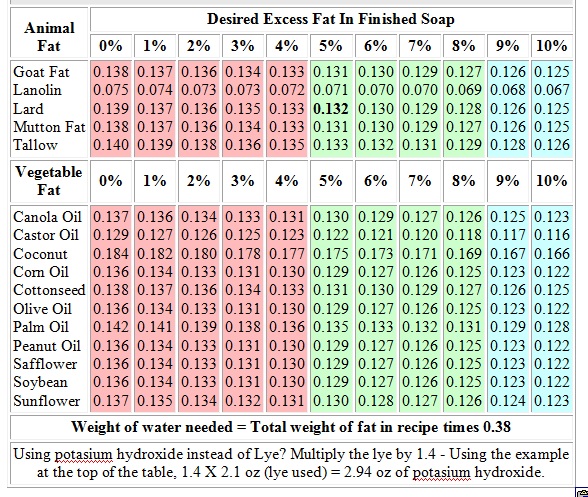This table is for those of you who want to get a bit more scientific in soap making or just want to check and see if the person who created the recipe you're planning on using knew what they were doing. Each fat has its own saponification value, or "SAP Value." Each fat requires a different amount of lye to convert the fat to soap.
For the soap to be made with no left over lye or fat you must have very accurate measuring equipment. As the same oil from different sources will have a slightly different saponification value, we recommend you keep your soap a bit fat heavy to ensure you don't end up with lye in your finished product.
In the table below use the 0-4% excess fat columns (red) if you have accurate technical equipment to test for excess fat or lye. Use the 5-8% excess fat columns (green) to make good hand/body soap and the 9-10% columns (blue) if you want excessively fat heavy soap.
This page was written under close consultation by Tina Howard at Majestic Mountain Sage. In fact, the following table was made using her lye calculator, which will automatically calculate the amount of lye you need for a large variety of different fats. You plug into her calculator the fats and quantities and it returns how much lye you'll need.
Calculate the amount of lye you need by multiplying the amounts of each fat (including superfatting oil) in your recipe by the number intersected by the fat and your desired excess fat column. Then add the different lye amounts for the different fats in your recipe together.
Example: You want to calculate the amount of lye for a recipe that calls for for 16 oz. of lard as it's only fat. You want your finished soap to have 5% excess fat. Intersecting the Lard row with the 5% column, you find the number 0.132. Multiply 16 (fat wt) by 0.132 = 2.1 oz. of lye.
Why different oils have their own SAP values: It all has to do with the length of the fatty acid chain. Briefly, it takes the same amount of lye to saponify a short fatty acid molecule as it does to saponify a long fatty acid molecule. The longer a fatty acid molecule is, the more a set number of them weigh. Saying this in another way, the longer chain fatty acids have a higher molecular weight. Hence, it takes less lye to saponify the longer chain fats. You can determine which fats above are the longer chain fats by looking at their SAP values. The higher the SAP number, the shorter the chain. Most of the fats above revolve around 18 carbon chain molecules with the sap value hovering around .136-.140 in the 0% Excess Fat Column. (The reason they are all slightly different is because the mixture of different fatty acids in each fat or oil is slightly different.) On the other hand, coconut oil contains about 47% lauric (C12), 19% myristic (C14), 9.5% palmitic acid (C16) and 20-25% other residues. Because coconut oil has several shorter string molecules, it takes more lye to turn a given weight of them into soap. Coconut's SAP value is .184. The reason for this is: the smaller the molecule, the more you can fit into a given volume. The more you can fit in a given volume, the more saponifiable bonds will be required and the more base you will consume.
Speaking of a molar (equal number of molecules) ratio, then it takes an equal level of base to saponify the fat/oil, although the larger molecule will have a larger volume.
This is a link to a soap calculator shared with us from Savvy Homemade that may be of help to you: https://www.savvyhomemade.com/soap-calculator/


